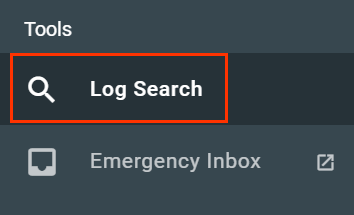Uzyskuj dostęp do wiadomości e -mail poddanych kwarantannie i zwalniaj je przy użyciu zaawansowanych zabezpieczeń poczty e -mail
Dzięki zaawansowanym zabezpieczeniom poczty e -mail użytkownicy i administratorzy mogą wyszukiwać i zwalniać wiadomości e -mail poddane kwarantannie. Wiadomości e -mail są poddawane kwarantannie, gdy podejrzewa się, że zawierają złośliwe oprogramowanie lub phishing.
Zaawansowane zabezpieczenia poczty e -mail mogą poddawać kwarantannie wiadomości, których Microsoft 365 może nie udostępniać, w wyniku czego te wiadomości e -mail będą przechowywane w kwarantannie Advanced Email Security. Możesz przejrzeć wiadomości poddane kwarantannie, a następnie zdecydować, co z nimi zrobić, np. Zwolnić je lub usunąć.
- Zaloguj się na stronie Zaawansowane zabezpieczenia poczty GoDaddy (użyj nazwy użytkownika i hasła GoDaddy).
- Wybierz opcję Zaloguj się do zaawansowanych zabezpieczeń poczty e -mail . Otworzy się strona logowania.
- Wprowadź swój adres e -mail, wybierz Zaloguj się , a następnie Zaloguj się za pomocą firmy Microsoft .
- Postępuj zgodnie z instrukcjami na ekranie, aby zalogować się przy użyciu adresu e -mail i hasła Microsoft 365. Otworzy się portal Zaawansowane zabezpieczenia poczty e -mail.
- Wybierz opcję Szukaj w dzienniku .

- Wybierz kartę, która pasuje do tego, czy jesteś administratorem, czy użytkownikiem.
- Wybierz Określony użytkownik , a następnie adres e -mail, który ma wiadomości poddane kwarantannie.

- W obszarze Typ wybierz, czy wiadomość e -mail była wychodząca, czy przychodząca, a następnie wybierz zakres dat, w którym wiadomość e -mail została wysłana lub odebrana.
- W obszarze Status wybierz opcję Kwarantanna .
- Wybierz opcję Szukaj . Zwraca listę wiadomości poddanych kwarantannie dla tego użytkownika w ramach określonych filtrów.

- Aby podjąć działania związane z konkretną wiadomością, w obszarze Akcje wybierz
 Podgląd . W tym miejscu możesz wykonać następujące czynności:
Podgląd . W tym miejscu możesz wykonać następujące czynności:
- Zwolnij : zwolnij wiadomość z kwarantanny w celu dostarczenia jej do skrzynki odbiorczej adresata.
- Zwolnij i zgłoś : Zwolnij wiadomość z kwarantanny, aby została dostarczona do skrzynki odbiorczej adresata, i zgłoś ją jako fałszywie trafioną (e -mail, który został nieprawidłowo oznaczony jako spam).
- Usuń : Usuń wiadomość z kwarantanny. Wiadomość nie zostanie dostarczona do adresata i nie będzie można jej odzyskać.

- Aby wykonać działanie na wielu wiadomościach, zaznacz pole wyboru obok każdej wiadomości. Nad listą wiadomości wybierz Akcje , a następnie jedną z następujących opcji:
- Zwolnij z kwarantanny : Dostarcz wybrane wiadomości do skrzynek odbiorczych odbiorców.
- Zwolnij i zatwierdź : Dostarcz wiadomości do skrzynek odbiorczych odbiorców i dodaj nadawcę do listy dozwolonych, aby przyszłe wiadomości od tego samego nadawcy nie były poddawane kwarantannie.
- Zgłoś jako fałszywie trafione : Zaznacz wybrane wiadomości jako wiarygodne wiadomości e -mail, które zostały nieprawidłowo zidentyfikowane jako spam.
- Zgłoś jako fałszywie negatywne : oznacz wybrane wiadomości jako spam lub złośliwe oprogramowanie, nawet jeśli nie zostały poddane kwarantannie.
- Ukryj wiadomości e -mail w dziennikach : Ukryj wiadomości, aby nie były wyświetlane w dzienniku.
Uwaga: Zgłaszanie wielu wiadomości jako fałszywie pozytywnych lub fałszywie negatywnych jest funkcją dostępną tylko dla administratora.
- W obszarze Typ wybierz, czy wiadomość e -mail była wychodząca, czy przychodząca, a następnie wybierz zakres dat, w którym wiadomość e -mail została wysłana lub odebrana.
- W obszarze Status wybierz opcję Kwarantanna .
- Wybierz opcję Szukaj . Zwraca listę wiadomości poddanych kwarantannie dla tego użytkownika w ramach określonych filtrów.

- Aby podjąć działania związane z konkretną wiadomością, w obszarze Akcje wybierz
 Podgląd . W tym miejscu możesz wykonać następujące czynności:
Podgląd . W tym miejscu możesz wykonać następujące czynności:
- Zgłoś błąd jako fałszywy alarm : zgłoś, że wiadomość została nieprawidłowo oznaczona jako spam.
- Zwolnij : zwolnij wiadomość z kwarantanny w celu dostarczenia jej do skrzynki odbiorczej adresata.
- Usuń : Usuń wiadomość z kwarantanny. Wiadomość nie zostanie dostarczona do adresata i nie będzie można jej odzyskać.

- Aby wykonać działanie na wielu wiadomościach, zaznacz pole wyboru obok każdej wiadomości. Nad listą wiadomości wybierz Akcje , a następnie jedną z następujących opcji:
- Zwolnij z kwarantanny : Dostarcz wybrane wiadomości do skrzynek odbiorczych odbiorców.
- Zwolnij i zatwierdź : Dostarcz wiadomości do skrzynek odbiorczych odbiorców i dodaj nadawcę do listy dozwolonych, aby przyszłe wiadomości od tego samego nadawcy nie były poddawane kwarantannie.
- Ukryj wiadomości e -mail w dziennikach : Ukryj wiadomości, aby nie były wyświetlane w dzienniku.
Może minąć do 24 godzin, zanim wiadomość e -mail zwolniona z kwarantanny pojawi się w skrzynce odbiorczej. Jeśli wystąpi błąd, odczekaj 5 minut i spróbuj ponownie.
Domyślnie wiadomości e -mail poddane kwarantannie są przechowywane lub przechowywane w kwarantannie przez 30 dni. Administrator może zmienić okres przechowywania w swoich ustawieniach podsumowania kwarantanny.
Powiązane czynności
- Zaktualizuj listy bezpiecznych i zablokowanych nadawców, aby zapewnić, że określone wiadomości są przesyłane do kwarantanny.
- Aby zmienić osoby, które mogą zwalniać wiadomości e -mail poddane kwarantannie, edytuj ustawienia spamu .
Więcej informacji
- Wykorzystaj w pełni zaawansowane zabezpieczenia poczty e -mail
- Zwolnij lub usuń wiadomość poddaną kwarantannie przez Microsoft 365
- Jeśli te kroki nie pasują do Twojego panelu Zaawansowane zabezpieczenia poczty e -mail, być może korzystasz z INKY. Sprawdź nasz plik PDF, aby uzyskać pomoc dotyczącą zaawansowanych zabezpieczeń poczty e -mail obsługiwanych przez INKY .